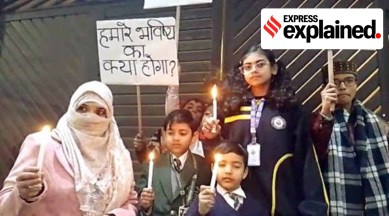SC order in Haldwani case: What the apex court said on Uttarakhand HC ruling
What is the Haldwani case and how did it reach the courts? What had the Uttarakhand High Court ordered earlier and what has the apex court now observed? We explain.

The Supreme Court Thursday stayed the orders of the Uttarakhand High Court in the Haldwani case, where it had allowed the use of force to evict 4,000 families living on what the Railways claims is its land.
Stating that the issue has a human angle and the people should be rehabilitated, the SC said, as reported by Bar and Bench, “What is troubling us is how do you deal with a situation where people bought in auction and took possession after 1947 and acquired title… People lived for 60-70 years some rehabilitation has to be done…Even in those cases where there are no rights at all even in them rehabilitation has to be done. But in some cases where they acquired title.. you have to find a solution. There is a human angle to this issue.”
What is the Haldwani case and how did it reach the courts? What had the Uttarakhand High Court ordered earlier and what has the apex court now observed? We explain.
What the SC said today
On December 20 last year, the HC had directed Railways to give the residents one week’s time to move out, and after that, “to use the forces to any extent determining upon need, to evict forthwith the unauthorised occupants”.
The SC on Thursday said 50,000 people can’t be uprooted in seven days.
“The moot point to be considered is whether the complete land is to vest in the railways or whether the state government is claiming a part of the land. Apart from that, there are issues of occupants claiming rights in the land as lessees/auction purchasers. We are on the way the order has been passed as there cannot be uprooting of 50,000 people in 7 days. We do believe that a workable arrangement is necessary to segregate people who may have no rights in the land who will have to be removed, coupled with schemes of rehabilitation which may already exist while recognising the need of the railways,” a bench of Justices S K Kaul and A S Oka said.
The bench said that it was also conscious of the Railways’ needs. “We also don’t want you to be put to difficulty…In harmony, two things can occur,” the bench said.
How did the case reach the SC?
The case first went to the High Court in 2013, when one Ravi Shankar Joshi filed a writ petition regarding illegal sand mining in river Gaula, which flows along the Haldwani railway station. In the course of this hearing, it was claimed that some people living near the railway line were involved in the mining.
The Railways was then made a party in the case, and the HC in 2016 asked for the land to be cleared. Residents of this land went to the Supreme Court, which in 2017 told the High Court that the residents’ side should be heard too.
In Decmeber 2022, the HC once again said the land should be cleared. Its 176-page ruling said: “Owing to the certain most reckoned political shield, which was then being provided by the then ruling party for its political gains to the unauthorised occupants, just to secure its vote bank, the State itself has filed a Review Petition, for no subsisting and valid reasons… seeking review of the judgment dated 9th November, 2016, which too was dismissed by the Division Bench vide its judgment dated 10th January, 2017…”
This order led to protests by the residents, who said they would be left homeless if driven out of homes they have lived in for years.
Competing claims on land
Residents have said they have deeds for the land, and have ben living here for decades. The Railways, on the other hand, claims they maps, a notification of 1959, revenue records from 1971 and the results of the 2017 survey to prove their ownership of the land.
Spread over a 2.2 km strip of land, the affected area covers the slums of Gafoor Basti, Dholak Basti and Indira Nagar – all falling under Banbhoolpura area of Haldwani — and is home to at least three government schools, 11 accredited private schools, 10 mosques, 12 madrassas, one government public health centre and one temple.